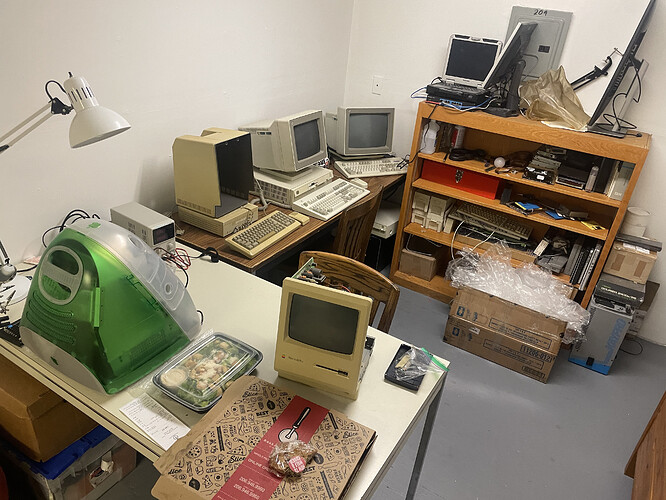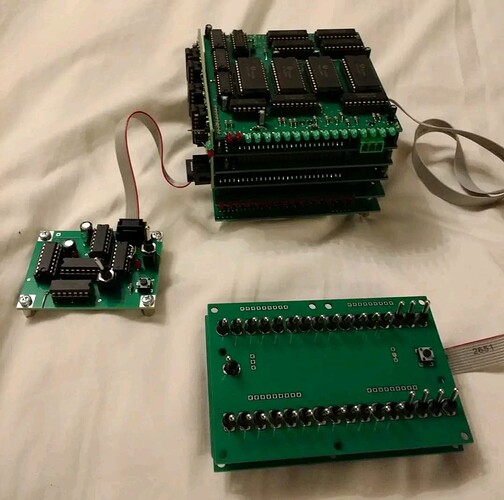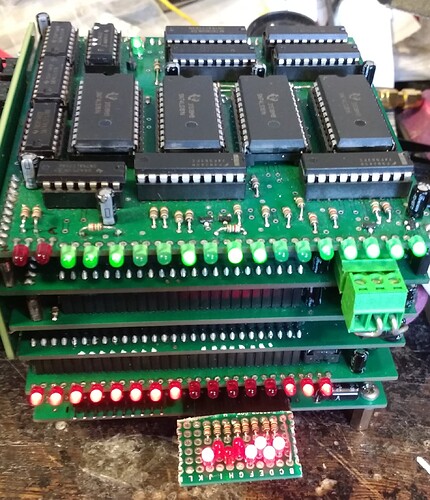Yes, I lucked into it last fall. It is awesome and a lot of fun!
Hi. Some known faces here. I’m gonna guess this forum was created in response to the demise of Google+. Am I right, @EdS?
My name is Juan Carlos Castro. I was born in 1965, and my first contact with computers was in college, at the age of 17. Simultaneously, a TRS-80 Model I clone at home, and an S-100 CP/M computer and a B6900 mainframe at college. At 19, I got my first job at a company that built a TRS-80 Color Computer clone. Much ROM BASIC hacking with the help of the Unravelled book series. Got the retrocomputing bug in 2009, built a collection with many weird items, started hosting a retrocomputing podcast with 4 other friends. @jecel featured prominently on out site. (Hi!)
Welcome, Juan!
Yes, indeed, indeed it was. And it was a handy refuge, and a good way to get a running start. I think now the forum has a character of its own, and a membership which is not too strongly related to ex-membership of Google+ - which is all good, and a natural consequence of time passing.
Hi everyone! I’m Tim Lovern. I started on PDP-11s in the late 70’s and then moved on to the VAX platform. I did RSTS/E development, then VMS. I have a strong VMS background. I still do some consulting on OpenVMS today.
I have a strong interest in older 8 and 16 bit micros - like the Altair or the IMSAI, as well as the old Digital Equipment Corp (DEC) machines… glad to have stumbled into this site.
Hi,
I’m zedstarr (my first Elite commander’s name and it’s stuck; it’s me pretty much everywhere on the internet),
Hardware engineer at heart, but I know enough software to get me in trouble.
When I was 11 or 12 my grandfather taught me to solder and we worked our way through a Tandy/Radio Shack “65-in-1 hobby electronics” kit thing (wooden frame, cardboard base with spring terminals and wires) making all sorts of amazing things and I’ve never looked back… built my own audio mixer, guitar pedals, pre-amps and all sorts of test gear. Etching PCBs in my teenage bedroom and getting into big trouble for ferric chloride stains on everything.
Although I was the right age to be a BBC/Spectrum kid my parents thought “computers are a waste of money”(!!!) so I made do with getting a fix via friends’ machines or using machines at school/college/Uni. Generally BBC/Nascom basic machines and then later the dreaded IBM PC.
That is until I started work and bought myself my first “proper” computer - a Psion Series 3 ![]() This was the start of a long-time obsession with Psion/Symbian and I owned pretty much everything Psion made post Series 3.
This was the start of a long-time obsession with Psion/Symbian and I owned pretty much everything Psion made post Series 3.
Over the years I’ve installed Linux on just about everything I possibly could - x86 desktops/laptops, Sun SPARC, HP-UX machines & even an old iPod and the Psion Series 5 too.
Lost count of the things I’ve blown up - started early again around the age of 10/11 with my dad’s 12V test screwdriver (bulb-in-clear-handle type) from the car toolkit that I found didn’t like mains voltage ![]()
Worked in Telecoms for ever, specialising in frequency standards (atomic clocks/GNSS) and other phase/time synchronisation technologies & systems. Hacked (un-paid pen-tester? ![]() ) Unix, VAX-VMS corporate systems at work and even the PBX back in the 1990s.
) Unix, VAX-VMS corporate systems at work and even the PBX back in the 1990s.
Greetings all, I’m primarily a mechanical calculator enthusiast and found my way here via a web search which brought up a thread that included a kind comment regarding a photograph of my Alpina.
I’m a regular visitor at TNMoC where I have annual membership, as well as the better known but now rather commercialised museum next door.
Looking forward to browsing through the many interesting topics here. Here’s a photograph of the highlights of my collection.

When I was an apprentice around 1970, mechanical calculators (with a hand crank or electric) were still commonplace. At that time, only the deputy head of department in accounting had an electronic desk calculator. A joke that we as apprentices were happy to allow ourselves was typing in a division with the maximum number of digits on an Olivetti shortly before the end of the lunch break. When the owner came back, he couldn’t use them for half an hour. He didn’t dare pull the plug because it could easily lead to jamming.
Greetings, everyone. I feel like I’m necroposting a little, but, since this IS the relevant thread, I think…
My name is Jamie. My friends call me Cappii or Goat (both symbolic of Capricorn). I’ve been working with computers since '03, and I’m generally self-taught, minus a few instruction sets with Linux when I was first introduced to it as an OS.
I’ve spent the last 20 years in both education and the private sector working with computers, macs, tablets, cell phones and IOT devices. My goal is always to provide the customers with the best services for the money, period. For example, even now, I only charge $25 for basic / no drivers / no backup Linux installs on desktops and laptops that support it, even unofficially. It’s not meant to be a money-maker, though. I currently manage a cell phone store that offers repair, and am the store’s sole repair man, and have been for just over a decade.
I’ve always leaned towards the hardware side of things, but recently I’ve been thrust into retrocomputing by way of a computer store owner / friend who sold me about a dozen Win 95-XP machines on the cheap. There were a few with bad drives, etc., but most are in working order. I’ve played around with several of them using AntiX-i386, but a couple are too old for even that to work. I’ve been debating on how, or if, I want to move forward with these as retrocomputers running the original OS for retrogaming, etc., or by installing a very lightweight Linux OS, such as Zorin Lite or AntiX, onto them to make them usable today.
Long story short, I have a lot to re-learn. When I first started, Windows 98SE was in it’s sunset days, Windows ME and 2K were the OSes du jour (lol @ ME being called an OS), and XP was just launching, although, IIRC, I didn’t mess with it much until SP1 came out. A lot has changed, including me, over the past 20 years.
I’d appreciate opinions, knowledge, and even a few laughs… God knows that we all could use more of that right now ![]()
Welcome, Tim, Chris, Jamie, and Mr_Curta! Thanks for your introductions and good to see you here. Be sure to use the forum search to find posts that might interest you, and feel free to resurrect old threads if you have something new to add.
Hi, I’m Fred Jan and I only became only recently aware of this forum (for me it isn’t retro, I never really stopped playing with '80-s computers ;-)).
Interested in smaller systems, usually Z80, sometimes 6809, soon PiDP-8. Hardware, software and documentation.
Site: https://electrickery.nl/
Greetings,
Fred Jan
Hi there!
My name is Michael and I am have been interested in retro computing and learning the fundamental building blocks on computer science for a long time, but I have finally just gotten to a point in my life where I can have some real time (and more importantly space) to dedicate to my hobby.
I have a particular love of anything IBM branded, and old Macs, but I am always on the lookout for anything unique, and I dream of someday owning a NeXTCube.
Cheers,
– Michael
Nice! I see a couple of Model-Ms lurking back there. I’m curious about that chicken salad; is it an Apple or IBM? What year? ![]()
Ha, the pizza place next door was running a meal special! That box on the floor has several more Ms in it, and one PC/XT model F, but those all arrived smashed up from ebay. ![]() Right now I’m wrestling with the Macintosh Plus’s floppy drive.
Right now I’m wrestling with the Macintosh Plus’s floppy drive.
Hi !
Wasn’t aware that this forum existed !
.
Im actually an RF engineer by trade, but I guess computing (or rather, building computer hardware) has been a hobby since the 80s
Started with a bit of BASIC coding at school, then got an Ohio Superboard II, then (when it’s intermittent faults became a bit too much to deal with) cloned it onto veroboard (in “mess of wires style”) … several times
Decades later I’m still coding in assembler (low end PICs) in my job, and building TTL retro computers for the hell of it
Currently working on a fairly compact (stack of 10cm square boards) 16 bit machine, and a very minimal (16 chips) 8 bit unit as a design exercise
.
Welcome, Fred, Michael, and Michael! We’re glad to have you all here. Please jump into any threads that interest you, and feel free to share what you’re working on!
Hi Guys,
I’m Augusto Baffa from Rio de Janeiro (Brazil) and I’m first contact with computers was a ZX81 and after an Apple][+. Since, I grew up with x86 computers (beginning on a PC XT - ok 8088 but almost same thing).
My interest in retro is in DIY and homebrew projects. It’s an excelent playground for learning about architectures and flipflop level coding ![]()
I have tinkered with all sorts of computers over the years including Apple, Macintosh, and various DOS/Windows PC’s. I have enjoyed Geos/New Deal/Ensemble. Since I retired i deleted the virus known as Windows 10 from my laptop and now use Linux Mint. My current project and the one that brings me here is an Epson ActionNote 4SLC2-50 running MS-DOS 7.10 (adapted from Win98). My present task is to get it communicating with my home network and the Internet.
Welcome aboard! Enjoy the site, lots of great info!
Hi guys.
My name’s Martin, but I usually go by ceptimus on forums and YouTube, etc.
Been programming now for over 45 years. Started with BASIC on PETs, then moved to 6502 machine code. I’ve done various Assembler: Z80, 6502, 6809, H8, 68000, 8051, etc. I still own a ZX Spectrum and an Amiga. Enjoy tinkering with Arduinos and other microcontrollers, in lots of languages. Recently I’ve implemented a (mostly ANS compliant) Forth for the MSP430, all written using Alfred Arnold’s great (and free) macro assembler ASL.
Fenny, does the Epson ActionNote have any sort of networking hardware? All I see on it are two serial ports and a parallel port.
Ethernet can be added using a Xircom PE3 type device. These attach to the parallel port and they provide real Ethernet, but the performance is limited due the parallel port. The other option is to use SLIP connects through the serial ports. SLIP requires another computer to serve as a router unless you use something like one of the ESP8266 “WiFi” modems with a SLIP firmware on them. (The SLIP firmware handles the routing.)


